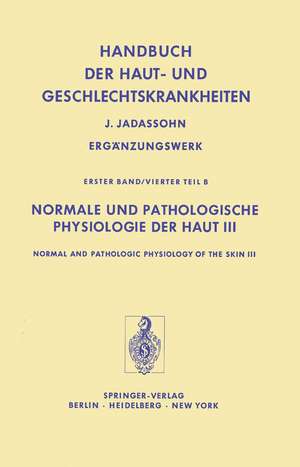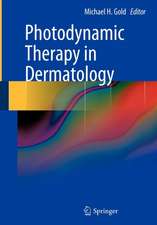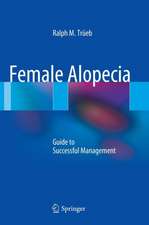Normale und Pathologische Physiologie der Haut III / Normal and Pathologic Physiology of the Skin III: Handbuch der Haut- und Geschlechtskrankheiten. Ergänzungswerk, cartea 1 / 4 / b
Autor W. -G Forssmann Editat de G. Stüttgen Autor A.J. Jong Editat de E. Schwarz Autor JWH MALI, D.A. Reay, H. Schäfer, F.A.J. Thiele, H.W. Spieren Limba Engleză Paperback – 21 dec 2011
Din seria Handbuch der Haut- und Geschlechtskrankheiten. Ergänzungswerk
- 5%
 Preț: 524.25 lei
Preț: 524.25 lei - 5%
 Preț: 522.50 lei
Preț: 522.50 lei - 5%
 Preț: 542.26 lei
Preț: 542.26 lei - 5%
 Preț: 690.84 lei
Preț: 690.84 lei - 5%
 Preț: 580.69 lei
Preț: 580.69 lei - 5%
 Preț: 427.36 lei
Preț: 427.36 lei - 5%
 Preț: 447.99 lei
Preț: 447.99 lei - 5%
 Preț: 421.85 lei
Preț: 421.85 lei - 5%
 Preț: 386.77 lei
Preț: 386.77 lei - 5%
 Preț: 431.91 lei
Preț: 431.91 lei - 5%
 Preț: 433.72 lei
Preț: 433.72 lei - 5%
 Preț: 427.89 lei
Preț: 427.89 lei - 5%
 Preț: 549.86 lei
Preț: 549.86 lei - 5%
 Preț: 550.02 lei
Preț: 550.02 lei - 5%
 Preț: 415.99 lei
Preț: 415.99 lei - 5%
 Preț: 435.39 lei
Preț: 435.39 lei - 5%
 Preț: 464.10 lei
Preț: 464.10 lei - 5%
 Preț: 454.40 lei
Preț: 454.40 lei - 5%
 Preț: 546.09 lei
Preț: 546.09 lei - 5%
 Preț: 380.72 lei
Preț: 380.72 lei - 5%
 Preț: 450.94 lei
Preț: 450.94 lei
Preț: 759.98 lei
Preț vechi: 799.97 lei
-5% Nou
Puncte Express: 1140
Preț estimativ în valută:
145.44€ • 150.98$ • 121.27£
145.44€ • 150.98$ • 121.27£
Carte tipărită la comandă
Livrare economică 25 martie-08 aprilie
Preluare comenzi: 021 569.72.76
Specificații
ISBN-13: 9783642674365
ISBN-10: 3642674364
Pagini: 972
Ilustrații: XXII, 950 p. 298 illus.
Dimensiuni: 170 x 244 x 55 mm
Greutate: 1.52 kg
Ediția:Softcover reprint of the original 1st ed. 1981
Editura: Springer Berlin, Heidelberg
Colecția Springer
Seriile Handbuch der Haut- und Geschlechtskrankheiten. Ergänzungswerk, Marchionini,A.(Hg):Haut-Geschl.krh. Erg. Bd 1
Locul publicării:Berlin, Heidelberg, Germany
ISBN-10: 3642674364
Pagini: 972
Ilustrații: XXII, 950 p. 298 illus.
Dimensiuni: 170 x 244 x 55 mm
Greutate: 1.52 kg
Ediția:Softcover reprint of the original 1st ed. 1981
Editura: Springer Berlin, Heidelberg
Colecția Springer
Seriile Handbuch der Haut- und Geschlechtskrankheiten. Ergänzungswerk, Marchionini,A.(Hg):Haut-Geschl.krh. Erg. Bd 1
Locul publicării:Berlin, Heidelberg, Germany
Public țintă
ResearchCuprins
The Water Balance of the Horny Layer and the Functional Characteristics of the Atrichial Sweat Glands of Human Skin.- I. The Functions of the Atrichial (Human) Sweat Gland.- Measurements on the Surface of the Skin and its Sweat Glands.- II. A Possible Contribution to Heat Transfer Through the Human Skin by the Eccrine (Atrichial) Sweat Gland.- Nomenclature Related to Heat Transport Capability of Sweat Glands and Calculation of Heat Pipe Performance.- III. Multivariate Data and Discriminant Analysis in Dermatology and Skin Physiology. (The Evaluation of Spontaneous Pathological Skin Conditions).- 1. Introduction.- 2. Remarks Concerning the Problem of Interdisciplinary Cooperation.- 3. The Approach to the Problem.- 4. Multivariate Data Analysis.- 5. Methodology of Statistical Analysis in Dermatology.- IV. The Sweat Gland and the Stratum Corneum.- I. General Introduction.- II. The Amino Acids, Lactic Acid, Urea, and Other Essential Components of Aqueous Skin Surface Extracts (Experimental Test Solutions), Human Sweat (Capillary-Collected) and Horny Layer Eluates (Aqueous Filtrate of Pulverized Defatted Callus).- III. The Horny Layer and Epidermal Proteins — The Isolation and Physical and Chemical Properties of Horny Layer Proteins.- IV. Solution Properties of Skin Proteins.- V. The Optical Activity of Skin Proteins and Skin Protein Substitutes (Synthetic Copolymers).- VI. Review of the Data Related to the Water Binding by Proteins and the Multicomponent System of the Horny Layer (Hydration and Dehydration) and the Possible Role of the Constituents of the Exudation of the Sweat Gland.- References.- Pharmacology of the Microvasculature of the Skin.- Foreword.- I. Introduction.- II. Functional Morphology of the Skin Microvasculature.- III. Methods of Investigation of theFunction of Microvasculature.- IV. Functional Data on the Skin Microcirculation.- V. Blood Coagulation and Microcirculation.- VI. The Fibrinolytic System and Microcirculation.- VII. Rheology and Microcirculation.- VIII. The Permeability of the Microvasculature.- IX. Lymph Flow and Microcirculation.- X. Reactivity of the Microvasculature.- XI. Pharmacological Influence on the Terminal Blood Vessels of the Skin.- XII. The Pharmacological Influence of Medicaments, which Interact with the Transmitter-Receptor Mechanism of the Autonomic Nervous System.- XIII. Corticosteroids and Microcirculation.- XIV. The Human Mucosa as a Test Area for Vasoactive Substances.- References.- Skin Permeability.- I. Introduction.- II. Morphologic Basis of Absorption by Human Skin.- III. Methods for Measurement of Absorption.- IV. Quantitative and Qualitative Aspects of Absorption.- V. Pharmacy of Topical Drugs.- VI. Therapy and Preparation Form.- VII. The Choice of Vehicle in Skin Diseases.- VIII. Pharmacodynamic Activities of Locally Applied Drugs to Normal and Diseased Skin.- IX. Special Cases and Modifying Factors Related to Topical Therapy.- X. Factors Influencing the Penetration.- XI. Toxicologic Aspects of Skin Permeability.- XII. Special Problems Encountered in Penetration.- XIII. Flux.- XIV. General Rules.- XV. Substances Investigated in Penetration and Related Fields.- References.- Index of Names.














